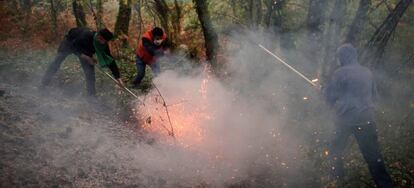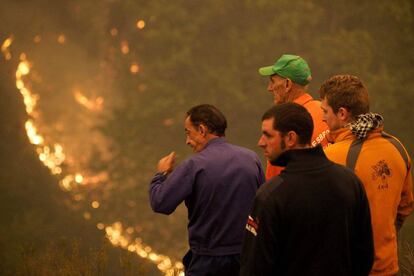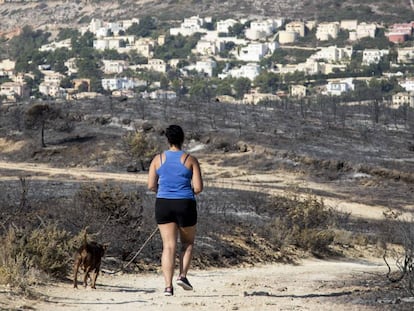‘Fall from hell’ in Galicia as fires lay waste to region
Spanish PM and regional leader label deliberately lit blazes “incendiary terrorism” in wake of devastation
Galicia, in Spain’s northwest, has for decades held the dubious honor of being a national leader when it comes serious fires. But now this fall, it is dealing with hellish blazes the likes of which it hasn’t seen before. In the most dangerous wave of fires in recent history four people have died – people who were trying to escape, who were fighting the flames, or protecting their livestock. Upward of 125 simultaneous outbreaks have also devastated thousands of hectares of land; the final number is not yet known. Currently, 23 fires remain active in the region.

The outbreaks have caused panic in the urban area of Vigo, a city on the Atlantic coast, devouring houses, industrial buildings, cars, and natural areas. On Monday rain, wind and a drop in temperatures calmed the fires in Pontevedra province, but the battle lines moved to the bordering provinces of Lugo and Ourense.
Upward of 125 simultaneous outbreaks have devastated the region. Currently, 23 fires remain active
Meanwhile, beyond Galicia, in the neighboring region of Asturias, some 30 fires forced dozens of people to evacuate.
Evidence indicates that a majority of the fires were intentionally lit and the regional government has decreed three days of mourning. Galician regional premier Alberto Núñez Feijóo says that the community is fighting “against the impossible,” while the opposition and environmentalists argue that the forestry policies of recent years have aggravated the magnitude of the destruction. On Monday night, despite the presence on the ground of 5,600 firefighters working to put out the fires and improved weather conditions, 50 fires remained active, nine of which presented a danger to populated areas. The intense smoke complicated the use of aerial technology due to low visibility.
The wave of fires also affected Asturias, where around 30 outbreaks forced evacuations, road closures and the suspension of classes in 23 schools. Smoke also reached neighboring regions south of the fire. “The best areas for brown bears are being burned. These are intentional fires that were meant to do damage, a lot of damage. It’s dramatic,” says Guillermo Palomero, president of the Brown Bear Foundation (FOP).
Thousands of people risked their lives to defend their homes from the flames with hoses and buckets of water
Thousands of people in the region woke up exhausted on Monday after an endless night of risking their lives to put out the flames using buckets of water and water hoses to defend their homes. In Vigo, at mid-morning on Monday only two of the 20 outbreaks that surrounded the city were yet to be extinguished. About 400 people were evacuated. Municipalities south of Pontevedra, found that in some cases the fires had destroyed 90% of their territory.
In Nigrán, a city on the northern coast, Marcelina Iglesia and Angelina Otero both died on Sunday night when they fled their house by car and got trapped on a highway. That same night, in Vigo, a 70-year-old died after falling while trying to extinguish a fire. In Carballeda de Avia, a city in western Galica, Marcelino Martínez, 78, lost his life trying to save his animals. The authorities have asked for help from residents to help find the perpetrators of the fires. So far, no arrests have been made.
“Incendiary terrorism”
The fires, said Spanish Prime Minister Mariano Rajoy, have not happened by chance. Rajoy visited the devastated areas yesterday, accompanied by the Galician regional premier. Both called for political action in 2006 when Galicia suffered from a similar string of fires. They are now calling it “incendiary terrorism.”

“There is intention to do harm,” Feijoo said. “Galicia did not burn on its own, someone burned it.”
Rain and a drop in temperature took a while to arrive in the Ourense and Lugo provinces. In inland Galicia, fires have devastated thousands of hectares of rural areas, places of key environmental value such as the Peneda-Xurés Natural Park, an area declared a Biosphere Reserve. The fire also hit the meadowlands of O Courel, located in the eastern mountains of Lugo province, and the forested Os Ancares region on the border of Galicia and Castilla y León.
Beside these natural reserves, the flames have also destroyed the Ribeira Sacra, a canyon region that is home to the highest concentration of Romanesque architecture in Europe.
The threat of fires forced countless villages to be evacuated, although some residents resisted doing so, clinging to the defense of their only assets: their homes and animals.
Galicia did not burn on its own, someone burned it Galician regional premier Alberto Núñez Feijóo
The Xurés Biosphere Reserve, on the Portugal border, is no stranger to fires. For decades, summer wildfires have blighted the region. So far this fall, fires have devastated more than 800 hectares in the area.
In Os Ancares, the government had believed a fire that started last Thursday was under control, but the flames returned, destroying more than 2,000 hectares of the natural reserve. The Galician countryside is now a desolate landscape.
English version by Debora Almeida.
Tu suscripción se está usando en otro dispositivo
¿Quieres añadir otro usuario a tu suscripción?
Si continúas leyendo en este dispositivo, no se podrá leer en el otro.
FlechaTu suscripción se está usando en otro dispositivo y solo puedes acceder a EL PAÍS desde un dispositivo a la vez.
Si quieres compartir tu cuenta, cambia tu suscripción a la modalidad Premium, así podrás añadir otro usuario. Cada uno accederá con su propia cuenta de email, lo que os permitirá personalizar vuestra experiencia en EL PAÍS.
¿Tienes una suscripción de empresa? Accede aquí para contratar más cuentas.
En el caso de no saber quién está usando tu cuenta, te recomendamos cambiar tu contraseña aquí.
Si decides continuar compartiendo tu cuenta, este mensaje se mostrará en tu dispositivo y en el de la otra persona que está usando tu cuenta de forma indefinida, afectando a tu experiencia de lectura. Puedes consultar aquí los términos y condiciones de la suscripción digital.
More information
Archived In
Últimas noticias
From digital curfews to blocking apps: How technology experts protect their children online
Why the price of coffee has skyrocketed: from Brazilian plantations to specialty coffee houses
Confined to a Cuban hospital: When electricity is a matter of life or death
The complicated life of Francesca Albanese: A rising figure in Italy but barred from every bank by Trump’s sanctions
Most viewed
- Why we lost the habit of sleeping in two segments and how that changed our sense of time
- Trump’s obsession with putting his name on everything is unprecedented in the United States
- Pablo Escobar’s hippos: A serious environmental problem, 40 years on
- The Florida Keys tourist paradise is besieged by immigration agents: ‘We’ve never seen anything like this’
- Charles Dubouloz, mountaineering star, retires at 36 with a farewell tour inspired by Walter Bonatti










































